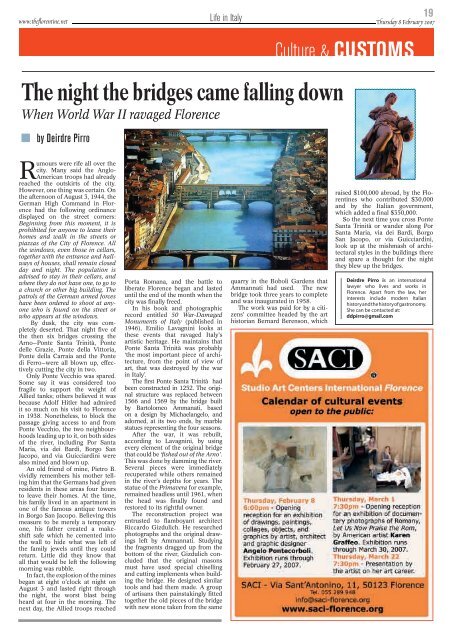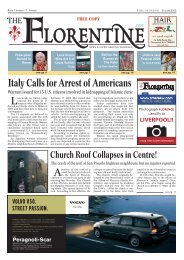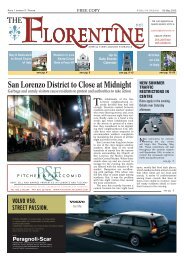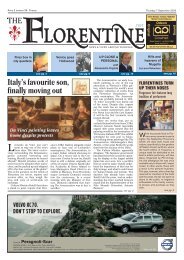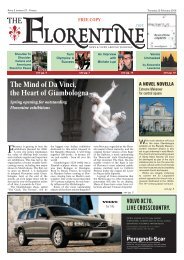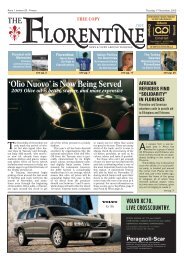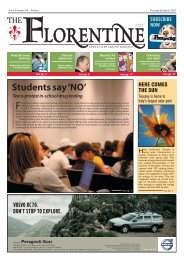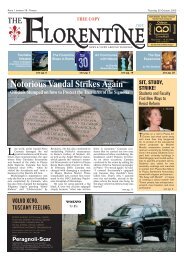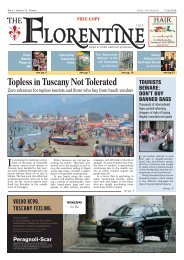Without the Arno, Florence would be like Romolo - The Florentine
Without the Arno, Florence would be like Romolo - The Florentine
Without the Arno, Florence would be like Romolo - The Florentine
Create successful ePaper yourself
Turn your PDF publications into a flip-book with our unique Google optimized e-Paper software.
www.<strong>the</strong>fl orentine.net<br />
Life in Italy<br />
<strong>The</strong> night <strong>the</strong> bridges came falling down<br />
When World War II ravaged <strong>Florence</strong><br />
by Deirdre Pirro<br />
Rumours were rife all over <strong>the</strong><br />
city. Many said <strong>the</strong> Anglo-<br />
American troops had already<br />
reached <strong>the</strong> outskirts of <strong>the</strong> city.<br />
However, one thing was certain. On<br />
<strong>the</strong> afternoon of August 3, 1944, <strong>the</strong><br />
German High Command in <strong>Florence</strong><br />
had <strong>the</strong> following ordinance<br />
displayed on <strong>the</strong> street corners:<br />
Beginning from this moment, it is<br />
prohibited for anyone to leave <strong>the</strong>ir<br />
homes and walk in <strong>the</strong> streets or<br />
piazzas of <strong>the</strong> City of <strong>Florence</strong>. All<br />
<strong>the</strong> windows, even those in cellars,<br />
toge<strong>the</strong>r with <strong>the</strong> entrance and hallways<br />
of houses, shall remain closed<br />
day and night. <strong>The</strong> population is<br />
advised to stay in <strong>the</strong>ir cellars, and<br />
where <strong>the</strong>y do not have one, to go to<br />
a church or o<strong>the</strong>r big building. <strong>The</strong><br />
patrols of <strong>the</strong> German armed forces<br />
have <strong>be</strong>en ordered to shoot at anyone<br />
who is found on <strong>the</strong> street or<br />
who appears at <strong>the</strong> windows.<br />
By dusk, <strong>the</strong> city was completely<br />
deserted. That night fi ve of<br />
<strong>the</strong> <strong>the</strong>n six bridges crossing <strong>the</strong><br />
<strong>Arno</strong>—Ponte Santa Trinità, Ponte<br />
delle Grazie, Ponte della Vittoria,<br />
Ponte della Carraia and <strong>the</strong> Ponte<br />
di Ferro—were all blown up, effectively<br />
cutting <strong>the</strong> city in two.<br />
Only Ponte Vecchio was spared.<br />
Some say it was considered too<br />
fragile to support <strong>the</strong> weight of<br />
Allied tanks; o<strong>the</strong>rs <strong>be</strong>lieved it was<br />
<strong>be</strong>cause Adolf Hitler had admired<br />
it so much on his visit to <strong>Florence</strong><br />
in 1938. None<strong>the</strong>less, to block <strong>the</strong><br />
passage giving access to and from<br />
Ponte Vecchio, <strong>the</strong> two neighbourhoods<br />
leading up to it, on both sides<br />
of <strong>the</strong> river, including Por Santa<br />
Maria, via dei Bardi, Borgo San<br />
Jacopo, and via Guicciardini were<br />
also mined and blown up.<br />
An old friend of mine, Pietro B.<br />
vividly remem<strong>be</strong>rs his mo<strong>the</strong>r telling<br />
him that <strong>the</strong> Germans had given<br />
residents in <strong>the</strong>se areas four hours<br />
to leave <strong>the</strong>ir homes. At <strong>the</strong> time,<br />
his family lived in an apartment in<br />
one of <strong>the</strong> famous antique towers<br />
in Borgo San Jacopo. Believing this<br />
measure to <strong>be</strong> merely a temporary<br />
one, his fa<strong>the</strong>r created a makeshift<br />
safe which he cemented into<br />
<strong>the</strong> wall to hide what was left of<br />
<strong>the</strong> family jewels until <strong>the</strong>y could<br />
return. Little did <strong>the</strong>y know that<br />
all that <strong>would</strong> <strong>be</strong> left <strong>the</strong> following<br />
morning was rubble.<br />
In fact, <strong>the</strong> explosion of <strong>the</strong> mines<br />
<strong>be</strong>gan at eight o’clock at night on<br />
August 3 and lasted right through<br />
<strong>the</strong> night, <strong>the</strong> worst blast <strong>be</strong>ing<br />
heard at four in <strong>the</strong> morning. <strong>The</strong><br />
next day, <strong>the</strong> Allied troops reached<br />
Porta Romana, and <strong>the</strong> battle to<br />
li<strong>be</strong>rate <strong>Florence</strong> <strong>be</strong>gan and lasted<br />
until <strong>the</strong> end of <strong>the</strong> month when <strong>the</strong><br />
city was fi nally freed.<br />
In his book and photographic<br />
record entitled 50 War-Damaged<br />
Monuments of Italy (published in<br />
1946), Emilio Lavagnini looks at<br />
<strong>the</strong>se events that ravaged Italy’s<br />
artistic heritage. He maintains that<br />
Ponte Santa Trinità was probably<br />
‘<strong>the</strong> most important piece of architecture,<br />
from <strong>the</strong> point of view of<br />
art, that was destroyed by <strong>the</strong> war<br />
in Italy’.<br />
<strong>The</strong> fi rst Ponte Santa Trinità had<br />
<strong>be</strong>en constructed in 1252. <strong>The</strong> original<br />
structure was replaced <strong>be</strong>tween<br />
1566 and 1569 by <strong>the</strong> bridge built<br />
by Bartolomeo Ammanati, based<br />
on a design by Michaelangelo, and<br />
adorned, at its two ends, by marble<br />
statues representing <strong>the</strong> four seasons.<br />
After <strong>the</strong> war, it was rebuilt,<br />
according to Lavagnini, by using<br />
every element of <strong>the</strong> original bridge<br />
that could <strong>be</strong> ‘fi shed out of <strong>the</strong> <strong>Arno</strong>’.<br />
This was done by damming <strong>the</strong> river.<br />
Several pieces were immediately<br />
recuperated while o<strong>the</strong>rs remained<br />
in <strong>the</strong> river’s depths for years. <strong>The</strong><br />
statue of <strong>the</strong> Primavera for example,<br />
remained headless until 1961, when<br />
<strong>the</strong> head was fi nally found and<br />
restored to its rightful owner.<br />
<strong>The</strong> reconstruction project was<br />
entrusted to fl amboyant architect<br />
Riccardo Gizdulich. He researched<br />
photographs and <strong>the</strong> original drawings<br />
left by Ammannati. Studying<br />
<strong>the</strong> fragments dragged up from <strong>the</strong><br />
bottom of <strong>the</strong> river, Gizdulich concluded<br />
that <strong>the</strong> original masons<br />
must have used special chiselling<br />
and cutting implements when building<br />
<strong>the</strong> bridge. He designed similar<br />
tools and had <strong>the</strong>m made. A group<br />
of artisans <strong>the</strong>n painstakingly fi tted<br />
toge<strong>the</strong>r <strong>the</strong> old pieces of <strong>the</strong> bridge<br />
with new stone taken from <strong>the</strong> same<br />
19<br />
Thursday 8 February 2007<br />
Culture & CUSTOMS<br />
quarry in <strong>the</strong> Boboli Gardens that<br />
Ammannati had used. <strong>The</strong> new<br />
bridge took three years to complete<br />
and was inaugurated in 1958.<br />
<strong>The</strong> work was paid for by a citizens’<br />
committee headed by <strong>the</strong> art<br />
historian Bernard Berenson, which<br />
raised $100,000 abroad, by <strong>the</strong> <strong>Florentine</strong>s<br />
who contributed $30,000<br />
and by <strong>the</strong> Italian government,<br />
which added a fi nal $350,000.<br />
So <strong>the</strong> next time you cross Ponte<br />
Santa Trinità or wander along Por<br />
Santa Maria, via dei Bardi, Borgo<br />
San Jacopo, or via Guicciardini,<br />
look up at <strong>the</strong> mishmash of architectural<br />
styles in <strong>the</strong> buildings <strong>the</strong>re<br />
and spare a thought for <strong>the</strong> night<br />
<strong>the</strong>y blew up <strong>the</strong> bridges.<br />
Deirdre Pirro is an international<br />
lawyer who lives and works in<br />
<strong>Florence</strong>. Apart from <strong>the</strong> law, her<br />
interests include modern Italian<br />
history and <strong>the</strong> history of gastronomy.<br />
She can <strong>be</strong> contacted at:<br />
ddpirro@gmail.com


